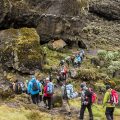1. Introduction: Embracing the High Country
If you’re dreaming of wild mountain landscapes, crisp alpine air, and trails that wind through jaw-dropping scenery, Rocky Mountain National Park is the place to be. Nestled in the heart of Colorado, this iconic park is a crown jewel for anyone who loves the outdoors—whether you’re a seasoned hiker or just getting started. The park’s rugged peaks, sparkling lakes, and dense forests have made it a beloved escape for generations of Coloradans and visitors alike.
Why Rocky Mountain National Park Matters
More than just a pretty backdrop, Rocky Mountain National Park holds a special place in Colorado’s culture. It’s where families make summer memories, college students challenge themselves on their first summit hike, and locals go to reconnect with nature after a busy week. From wildlife spotting to wildflower meadows, every visit offers something new.
What Makes the Park Unique?
| Feature | What to Expect |
|---|---|
| Elevation | Ranges from 7,500 ft to over 14,000 ft—perfect for those looking to experience true high country adventure. |
| Trail Variety | Over 350 miles of hiking trails for all skill levels—from easy strolls to challenging climbs. |
| Wildlife | Keep your eyes peeled for elk, moose, bighorn sheep, marmots, and countless bird species. |
| Cultural Significance | A cherished getaway for locals and a bucket-list destination for visitors from around the globe. |
Why Outdoor Enthusiasts Love It Here
No matter your skill level or outdoor interests, Rocky Mountain National Park welcomes everyone. You can take an easy walk around Bear Lake with your family or tackle a more demanding trek up Flattop Mountain. Photographers, birdwatchers, hikers, and nature lovers all find something to cherish here. With every step along its scenic trails, you’ll get a taste of why this park is considered one of America’s must-visit natural treasures.
2. Trail Tips: What to Know Before You Go
Essential Advice for Safe and Enjoyable Hiking in Rocky Mountain National Park
Exploring the trails of Rocky Mountain National Park is an incredible experience, but it’s important to be prepared. Here are some key tips to help you have a safe and memorable adventure, whether you’re a first-timer or a seasoned hiker.
Gear Recommendations: What to Pack
| Item | Why You Need It |
|---|---|
| Sturdy Hiking Boots | Rocky trails can be tough on your feet—good boots offer support and prevent slips. |
| Layered Clothing | Weather changes quickly in the Rockies; dress in layers to stay comfortable. |
| Rain Jacket/Windbreaker | Afternoon showers and gusty winds are common, especially at higher elevations. |
| Water & Snacks | Dehydration happens fast at altitude—bring plenty of water and high-energy snacks. |
| Sunscreen & Hat | The sun is stronger at higher elevations. Protect your skin! |
| Trekking Poles (optional) | Great for balance on rocky or steep sections of trail. |
| Map or GPS App | Cell service can be spotty; know your route before heading out. |
Altitude Awareness: Take It Slow
The park’s elevation ranges from about 7,500 feet to over 14,000 feet. Many visitors feel the effects of altitude, like shortness of breath or fatigue. Here’s how to handle it:
- Pace Yourself: Go slower than you think, especially if you’re not used to the elevation.
- Stay Hydrated: Drink more water than usual to help your body adjust.
- Avoid Alcohol: It can make altitude symptoms worse.
- Know the Signs: If you get dizzy, nauseous, or develop a headache, take a break or head to lower ground.
Weather in the Rockies: Be Prepared for Anything
The weather here can turn quickly. Mornings are usually clear, but afternoon thunderstorms are common—especially in summer. Always check the forecast before heading out and be ready to turn back if storms roll in. Lightning is a real danger above tree line!
Trail Etiquette Unique to the Rockies
- Yield Right-of-Way: Uphill hikers have the right-of-way. Step aside for horses and let faster hikers pass safely.
- Leave No Trace: Pack out everything you bring in—including trash and food scraps—to keep the park wild and beautiful.
- Wildlife Watching: Admire elk, moose, and marmots from a distance. Never feed animals, and give them plenty of space.
- Stay on Marked Trails: Shortcutting damages fragile alpine plants that take years to recover.
Your Rocky Mountain Adventure Awaits!
A little planning goes a long way toward making your hike safe, fun, and unforgettable. With the right gear and some smart habits, you’ll be ready for whatever the Rockies throw your way!
![]()
3. Easy Hikes: Scenic Walks for Everyone
If you’re looking for a laid-back way to soak in the beauty of Rocky Mountain National Park, there are plenty of easy hikes that offer stunning scenery without the sweat. These trails are ideal for families with kids, first-time visitors, or anyone wanting to enjoy mountain views at a relaxed pace.
Bear Lake Trail
The Bear Lake Trail is one of the park’s most popular and accessible hikes. This 0.6-mile loop is paved and mostly flat, circling the picturesque Bear Lake with jaw-dropping views of Hallett Peak and Longs Peak in the distance. Benches along the trail make it easy to stop and take in the alpine scenery or snap a few family photos.
Sprague Lake Loop
Another fantastic option is Sprague Lake Loop, a gentle 0.8-mile walk around a sparkling lake with dramatic mountain backdrops. The wide, level path is wheelchair-accessible and perfect for strollers. Early mornings here are magical, with mist on the water and possible wildlife sightings like elk or ducks.
Easy Hike Comparison Table
| Trail Name | Distance (Round Trip) | Elevation Gain | Highlights | Accessibility |
|---|---|---|---|---|
| Bear Lake Trail | 0.6 miles | Minimal | Alpine lake views, mountain vistas | Paved, wheelchair accessible |
| Sprague Lake Loop | 0.8 miles | Minimal | Lake views, wildlife spotting | Packed gravel, wheelchair accessible |
| Lily Lake Loop | 0.8 miles | Minimal | Lily pads, wildflowers (summer), mountain reflections | Packed gravel, stroller friendly |
Tips for Easy Hiking in Rocky Mountain National Park:
- Arrive early: Parking lots fill up quickly, especially at Bear Lake during peak season.
- Dress in layers: Weather can change fast—even on short walks.
- Pack snacks and water: There are no services on these trails.
- Respect wildlife: Keep your distance and don’t feed animals.
- Cameras ready: The mountain reflections on calm lakes are picture-perfect!
This selection of easy hikes ensures everyone can experience the awe-inspiring landscapes of Rocky Mountain National Park—no mountaineering skills required.
4. Moderate Treks: Step Up Your Adventure
Ready to take your Rocky Mountain adventure up a notch? If you’ve already tackled the easy trails or want a bit more challenge, the park offers some fantastic moderate hikes that blend manageable distance with jaw-dropping scenery. These trails are perfect for hikers who want to push themselves while still enjoying the best of what Rocky Mountain National Park has to offer.
Emerald Lake Trail
The Emerald Lake Trail is one of the most popular moderate hikes in the park—and for good reason! This 3.6-mile round-trip trail leads you past three stunning alpine lakes: Nymph, Dream, and finally Emerald Lake. Along the way, you’ll get classic views of rugged peaks, crystal-clear water, and lush pine forests. It’s a favorite for families with adventurous kids and anyone looking to experience postcard-worthy landscapes without an extreme climb.
Emerald Lake Trail at a Glance
| Distance (round-trip) | Elevation Gain | Trailhead | Highlights |
|---|---|---|---|
| 3.6 miles | 650 feet | Bierstadt Lake Trailhead | Three alpine lakes, epic mountain views |
Alberta Falls Trail
If you love waterfalls, Alberta Falls is a must-do moderate hike. The trail is about 1.6 miles round-trip, making it a great option if you’re short on time but still want a taste of adventure. The route winds through aspen groves and pine forest before reaching the roaring 30-foot Alberta Falls—a perfect spot for photos and a picnic break.
Alberta Falls Trail Quick Facts
| Distance (round-trip) | Elevation Gain | Trailhead | Highlights |
|---|---|---|---|
| 1.6 miles | 200 feet | Glacier Gorge Trailhead | Lush forest, waterfall views, wildlife spotting |
Trekking Tips for Moderate Hikes
- Pace Yourself: Even though these trails are rated as moderate, Colorado’s elevation can make things feel tougher than expected.
- Bring Layers: Weather can change quickly in the Rockies—bring a light jacket or rain shell just in case.
- Start Early: Parking lots fill up fast and afternoon thunderstorms are common in summer months.
- Stay Hydrated: Higher elevations mean you’ll need more water than usual—don’t forget your bottle!
5. Challenging Routes: For the Ambitious Explorer
If you’re ready to push your limits and experience some of the most breathtaking scenery in Colorado, Rocky Mountain National Park has several challenging hikes that will test your endurance and reward you with unforgettable views. The park’s high-altitude terrain is not for the faint of heart, but if you’re up for the adventure, trails like Sky Pond and Longs Peak are must-dos for any ambitious explorer.
Sky Pond
Sky Pond is a bucket-list hike known for its dramatic alpine lakes, waterfalls, and jagged peaks. The trail covers about 9 miles round-trip with around 1,800 feet of elevation gain, making it a strenuous journey. Along the way, you’ll pass Alberta Falls and climb a rock scramble near Timberline Falls before reaching the pristine waters of Sky Pond.
Local Tip:
The final stretch involves a wet rock scramble—wear sturdy hiking shoes with good grip, start early to beat afternoon thunderstorms, and pack plenty of water.
Longs Peak
Longs Peak is the crown jewel for peak-baggers in Rocky Mountain National Park. Standing at 14,259 feet, this iconic “fourteener” is a true challenge with a round-trip distance of about 15 miles and over 5,000 feet of elevation gain. Most hikers tackle the Keyhole Route, which involves steep switchbacks, boulder fields, and exposed ledges.
Local Tip:
Start before sunrise (think 2–3 AM) to avoid dangerous afternoon weather. Bring layers—temperatures can swing quickly—and don’t underestimate altitude sickness; take your time acclimating before attempting this hike.
Comparison Table: Challenging Day Hikes
| Trail Name | Distance (Round-Trip) | Elevation Gain | Main Highlights | Difficulty |
|---|---|---|---|---|
| Sky Pond | 9 miles | 1,800 ft | Alpine lakes, waterfalls, rock scramble | Strenuous |
| Longs Peak (Keyhole Route) | 15 miles | 5,000+ ft | Boulder field, Keyhole Pass, summit views | Very Strenuous / Technical |
Essential Tips for Conquering High Elevation Hikes
- Pace Yourself: Take breaks often and hydrate regularly—Colorado’s dry air can sneak up on you.
- Weather Awareness: Afternoon storms are common in summer. Always check the forecast and turn back if skies look threatening.
- Altitude Acclimation: Spend a day or two at higher elevations before tackling big hikes to help your body adjust.
- Leave No Trace: Respect local wildlife and stay on marked trails to preserve the park’s beauty for everyone.
Savoring Colorado’s Alpine Beauty
Pushing yourself on these challenging routes isn’t just about reaching the summit—it’s about soaking up sweeping mountain vistas, spotting wildflowers along the trail, and enjoying crisp alpine air. Whether you conquer Sky Pond or summit Longs Peak, you’ll carry these Rocky Mountain memories long after your boots come off.


